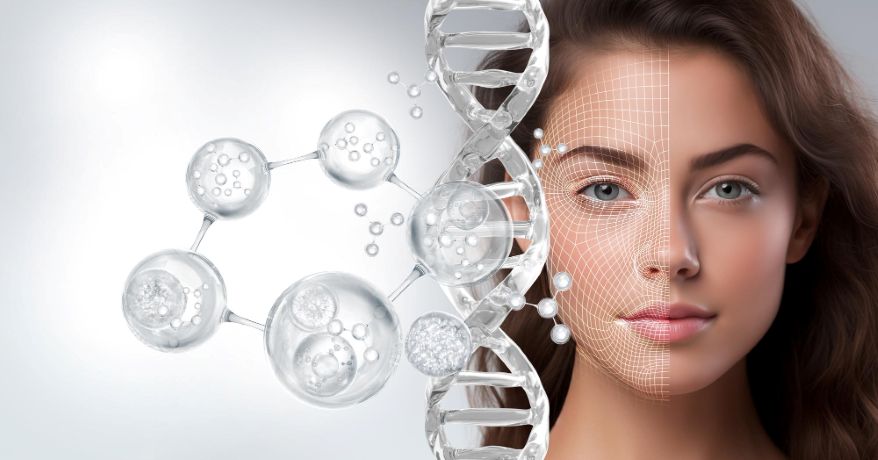Biomarkers Associated with Longevity
Today, we’re going to look into the science of aging and answer a big question: What are the signs in our bodies that are linked to living a long life? These signs are called biomarkers.
We’ll talk about what they are, why they matter, and how they might help us live longer and healthier. All the information comes from trusted, open-access science sources, so you can count on what you hear.
SECTION 1: What Are Biomarkers and Why Do They Matter?
Let’s start with the basics. A biomarker is something we can measure in our bodies that tells us about our health. When we talk about aging, biomarkers are things like molecules in your blood, certain genes, or even how fast you walk. Therefore, these things give us clues about how your body is really doing, not just how old you are by the calendar.
Why do we need these signs? Because your age in years doesn’t always match how healthy you are. Similarly, some people in their 80s are active and healthy, while others in their 60s may have many health problems. Biomarkers help us see these differences and could one day help doctors give advice that fits each person.
SECTION 2: The Scientific View—Looking at Many Signs Together
So, what do scientists think? Most agree that no single sign can tell us everything about aging. The best way is to look at a group of different signs together. Thus, these can include your genes, molecules in your blood, how well your body works, your daily habits, and even your mental health.
A group of experts in 2025 picked 14 important signs to use in studies about living longer. Hence, these include things like DNA changes, signs of swelling in the body, tests of how well you move, and checks of your memory and thinking. Let’s look at these, starting with your genes.

SECTION 3: Genetic Biomarkers—Your Body’s Blueprint
Your genes play a big part in how you age. Simultaneously, some people are born with gene types that help them live longer and stay healthy. Here are some of the most important gene signs:
1. FOXO3
- What is it? A gene that helps control how your body deals with stress and repairs itself.
- Why does it matter? People with a certain type of this gene often live longer. Hence, it helps protect the ends of your DNA, called telomeres, and lowers swelling in the body.
2. APOE
- What is it? A gene that helps your body handle fats.
- Why does it matter? One type, called APOE ε2, is linked to living longer and having a lower risk of memory loss and heart problems. Additionally, another type, ε4, raises the risk of these problems.
3. SIRT Genes
Why do they matter? SIRT1, for example, helps your body handle stress and may help you live longer, especially if you eat less.
What are they? A group of genes that help fix DNA and control how your body uses energy.
4. Telomere Length
- What is it? Telomeres are like the plastic tips on shoelaces, but for your DNA. Therefore, they get shorter as you age.
- Why does it matter? Longer telomeres are linked to living longer. Moreover, shorter ones mean a higher risk of getting sick as you get older.
SECTION 4: Molecular Biomarkers—Signals from Inside Your Body
Now, let’s talk about what’s happening inside your body. There are three main groups of signs that scientists look at:
1. Inflammatory Markers
- Key players: C-reactive protein (CRP), Interleukin-6 (IL-6), Tumor necrosis factor-alpha (TNF-α).
- Why important? Ongoing, low-level swelling in the body—called “inflammaging”. Additionally, it is a big part of getting older and is linked to being weak, getting sick, and dying sooner.
- How measured? Simple blood tests.
2. Oxidative Stress Markers
- Key players: Protein carbonyls, advanced glycation end products (AGEs), malondialdehyde (MDA), 8-OHdG.
- Why important? These show damage to your cells from things like pollution or stress. Hence, this damage can speed up aging.
- How measured? Blood or urine tests.
3. Metabolites
- Key players: Amino acids, fats, NAD+, sugar, and lactic acid.
- Why important? Thus, these show how well your cells are working and how your body uses food for energy. Similarly, some, like NAD+, are being studied to see if they can help us age better.
SECTION 5: Epigenetic Clocks—A New Way to Tell Your Body’s Age
One of the most exciting new tools in aging science is the epigenetic clock. Thus, this is a way to check your “biological age” by looking at small changes in your DNA called methylation.
- Why are they important? Thus, these clocks, like Horvath, Hannum, PhenoAge, and GrimAge, are very good at guessing your risk of getting sick or dying. Sometimes better than just knowing your age in years.
- How are they measured? By looking at your DNA from blood or spit samples.
SECTION 6: Functional and Lifestyle Biomarkers—How You Move and Live
How you move and live every day is just as important as your genes. Hence, here are some of the best signs linked to living longer:
1. Cardiorespiratory Fitness (CRF)
- Measured by: Indeed, tests like VO₂max or fitness trackers.
- Why important? People who are more fit have a lower risk of dying from any cause.
Muscle Strength and Function
- Measured by: Grip strength, how fast you walk, or how quickly you can stand up from a chair.
- Why important? Simultaneously, stronger muscles and faster walking are linked to living longer. Being weak or slow is a sign of higher risk.
3. Physical Activity Levels
- Measured by: Eventually, step counters, fitness trackers.
- Why important? Moving more each day lowers your risk of many diseases and helps you live longer .
4. Nutritional Biomarkers
- Measured by: Blood tests for vitamins, amino acids, fats, sugar, and signs of swelling.
- Why important? Additionally, eating well helps you age better. Not getting enough of certain nutrients can raise your risk of getting sick.
SECTION 7: Mental Health Biomarkers—The Mind-Body Link
Your mind matters too. Similarly, stress, sadness, and poor mental health can make your body age faster.
1. Stress Hormones
- Key player: Indeed, cortisol, the main stress hormone.
- Why important? High levels of cortisol over time are linked to memory loss, brain problems, and shorter life expectancy.
- How measured? Indeed, blood, spit, urine, or even hair samples.
2. Neuroinflammatory Markers
- Key players: IL-1β, IL-6.
- Why important? Stress and sadness can raise these, which can hurt your brain over time.
3. Neurotrophic Factors
- Key player: Brain-derived neurotrophic factor (BDNF).
- Why important? Low BDNF is linked to sadness and memory loss.
4. Neurotransmitters and Epigenetic Changes
- Key players: Serotonin, dopamine, norepinephrine, and changes in brain cells.
- Why important? Problems with these can speed up brain aging.

SECTION 8: How Are These Biomarkers Measured?
You might ask, How do scientists check these signs? Here’s a quick look:
- Genetic signs: DNA tests, gene checks, and tests for telomere length.
- Molecular signs: Blood and urine tests for proteins, fats, and signs of cell damage.
- Epigenetic clocks: Indeed, DNA tests from blood or spit.
- Functional and lifestyle signs: Simple tests like grip strength, walking speed, and using fitness trackers.
- Mental health signs: Eventually, hormone tests, brain scans, and tests for brain chemicals.
SECTION 9: Why Do These Biomarkers Matter?
Why do these signs matter? Because they show what’s really happening as we get older. Here are some of the main things that go wrong as we age:
- DNA damage: Our DNA gets hurt over time, which can make our cells work less well.
- Telomere shortening: The ends of our DNA get shorter, which can make cells stop working.
- Epigenetic changes: Also, small changes in our DNA can mess up how our genes work.
- Protein problems: Bad proteins can build up and cause diseases like Alzheimer’s.
- Mitochondria problems: Therefore, these are the parts of our cells that make energy. Thus, they get less good at their job as we age.
- Cell aging: Old cells can make the body swell and hurt nearby cells.
- Stem cell loss: Additionally, we lose the cells that help fix our bodies.
- Chronic inflammation: Ongoing swelling in the body can cause many diseases.
- Problems with how the body uses food: Our bodies get worse at using food for energy and handling stress.
SECTION 10: Putting It All Together—The Future of Living Longer
The future of aging science is about looking at all these signs together. Moreover, by checking your genes, blood, how you move, and your mental health, doctors can get a better idea of how old your body really is. And what you can do to stay healthy.
- Combining signs and using new computer tools helps make better guesses about your health and how long you might live.
- Smart computers are now being used to look at all this data and help doctors give advice that fits you.
Imagine a world where your doctor can use a simple blood test, a fitness tracker, and a DNA test to give you a plan for healthy aging. That world is coming soon!
SECTION 11: Challenges and What’s Next
Eventually, even with all this progress, there are still some problems:
- Proving cause and effect: Moreover, many signs are just linked to aging, but we don’t always know if changing them will help us live longer.
- Standard tests: Different labs use different ways to measure these signs, which can make it hard to compare results.
- Differences between people: Thus, these signs can work differently in people from different backgrounds.
But science is moving fast, and discoveries are happening all the time. Hence, the big goal is to use these signs to help everyone live longer and healthier.
So, what did we learn? Indeed, living a long life isn’t just about your genes or your age. It’s about what’s in your DNA, your blood, your muscles, your mind, and your daily habits. Thus, by measuring and understanding these signs, we’re learning how to help everyone live longer and better.
References
- Sebastiani, P., Thyagarajan, B., Sun, F., Schupf, N., Newman, A. B., Montano, M., & Perls, T. T. (2017). Biomarker signatures of aging. Aging Cell, 16(2), 329–338. https://doi.org/10.1111/acel.12557
- Miller, R. A. (2001). Biomarkers of Aging: Prediction of longevity by using Age-Sensitive T-Cell subset determinations in a Middle-Aged, genetically heterogeneous mouse population. The Journals of Gerontology Series A, 56(4), B180–B186. https://doi.org/10.1093/gerona/56.4.b180
- Chen, R., Wang, Y., Zhang, S., Bulloch, G., Zhang, J., Liao, H., Shang, X., Clark, M., Peng, Q., Ge, Z., Cheng, C., Gao, Y., He, M., & Zhu, Z. (2023). Biomarkers of ageing: Current state‐of‐art, challenges, and opportunities. MedComm – Future Medicine, 2(2). https://doi.org/10.1002/mef2.50
Additionally, to stay updated with the latest developments in STEM research, visit ENTECH Online. Basically, this is our digital magazine for science, technology, engineering, and mathematics. Furthermore, at ENTECH Online, you’ll find a wealth of information.
Disclaimer: We do not intend this article/blog post to provide professional, technical, or medical advice. Therefore, please consult a healthcare professional before making any changes to your diet or lifestyle. In fact, we only use AI-generated images for illustration and decoration. Their accuracy, quality, and appropriateness can differ. So, users should avoid making decisions or assumptions based only on the text and images.

